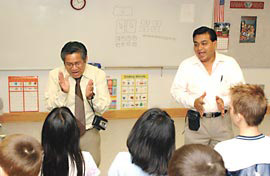 |
 |
 |
 Vallarta Living | June 2005 Vallarta Living | June 2005  
Program Pairs Mexican Teachers with Newly Arrived Students
 Luz Peña - Vida en el Valle Luz Peña - Vida en el Valle


| | Antonia Martin Sanpedro, left, and Enrique Aguilar Hernandez teach students a song in Spanish. (Photo: Amanda Shavers/The Cullman Times) |
When Símon Pérez talks about math, his eyes light up.

Pérez believes math should be taught in a way that engages students. The Roosevelt High School teacher's classroom is covered with bright pink, yellow and orange poster board with math equations and terms written in Spanish. He uses other tools like beads, building blocks and a website to help students master math in their own language, Spanish.

Pérez began working at Roosevelt where the student population is 70 percent Mexican and MexicanAmerican in 1996 as part of the Binational Program, a program designed to match up Mexican teachers with students in the United States who are learning English as a second language. Because the teachers know the language and the culture, he says, they are able to teach according to the students' needs.

"The students who have recently come from Mexico don't speak English at all. They're from rural areas. The truth is students from the rural areas of Mexico, though they graduated from elementary and middle school, are not at grade level," said Pérez, who was honored recently as teacher of the year by the Fresno chapter of the Association of Mexican American Educators.

"Their reading level is below elementary, and they work in the fields, so they are absent from school a lot. It's different when you have student from urban areas. They are much better prepared, but they are in the same situation: they don't speak English."

To qualify for the program, the teachers must have a Preliminary Single Subject Teaching credential; Clear Crosscultural, Language and Academic Development Certificate, (CLAD); Clear Bilingual, Crosscultural, Language and Academic Development certificate (BCLAD); and speak Spanish.

Dr. Nancy Jean Smith, professor of Education at California State University, Stanislaus, says these programs help students by allowing them to maintain their language and identity.

Smith also helps coordinate Transformative Literacy, a twoweek program in which teachers go to the Mexican state of Oaxaca to learn about Zapotec traditions and take classes in science and other subjects taught entirely in Spanish.

"When they walk into a classroom, the teachers ask themselves, 'How do the kids learn so much when there are so few resources?'” she says. “They don't do it for the money, but for the love of teaching. That's why teachers are so respected in Mexico."

Pérez says he likes his students to work in groups, with one person in each group facilitating. This gives them a handson approach to learning, he says, instead of trying to understand a lecture where there is no real interaction between the students and the teacher.

“Our future quality of life depends on the quality of our education,” he says. "If today’s students don’t get a good education, then all of us are going to be in trouble."

The Mexican government helps pay for teachers like Pérez to come to the United States. School districts help cover additional costs.

But it's rare for these teachers to stay in the United States for more than two years. They usually teach a summer program and return to Mexico after a short period of time. Pérez says he only knows three or four other teachers from his group who are still in the United States.

Although he misses Mexico, Pérez says he likes the United States and knows the program is valuable for both countries.

"I’m helping my country,” he says, “because I’m helping the Mexican students who come here. And I’m helping this country at the same time." | 
 | |
 |



